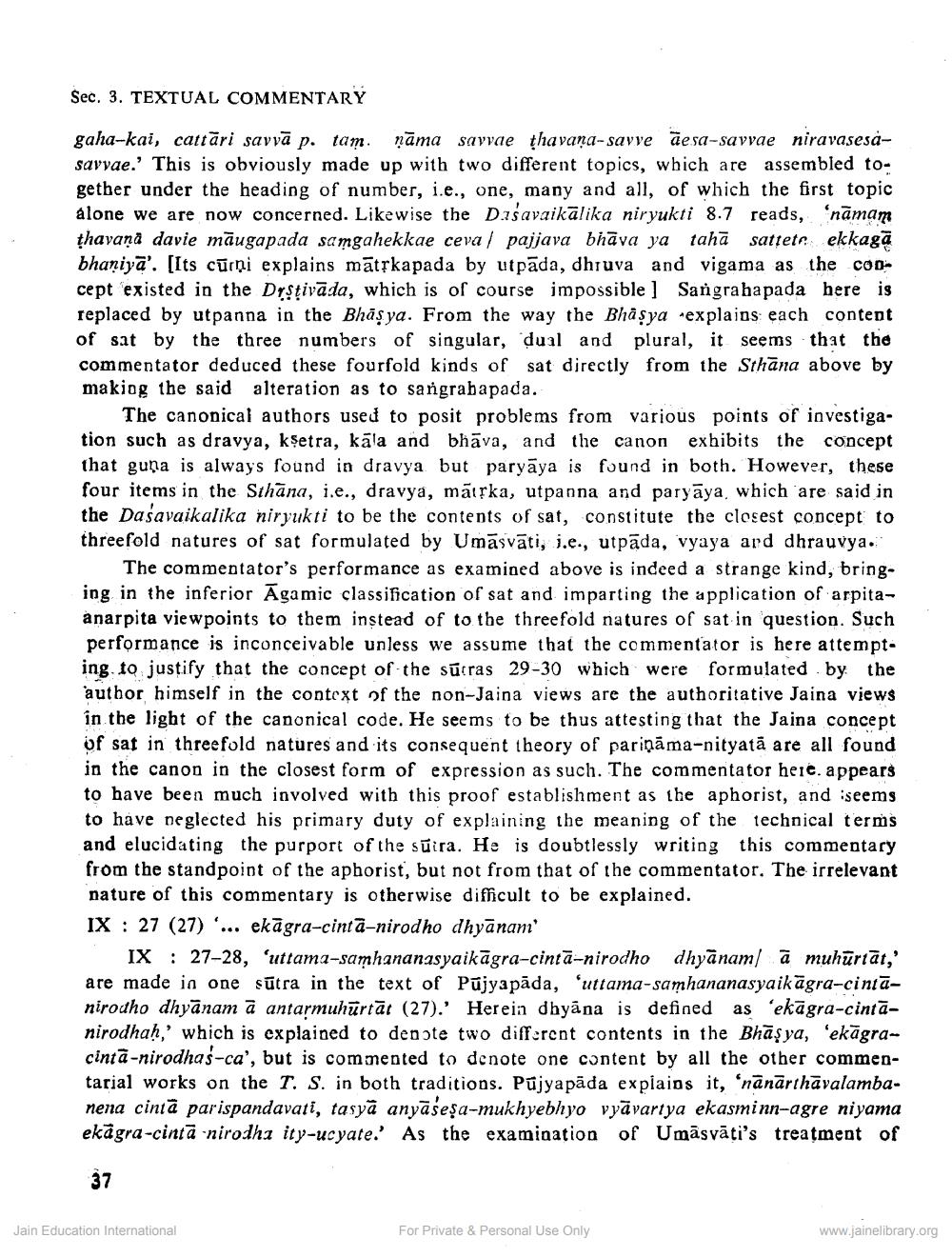________________
Sec. 3. TEXTUAL COMMENTARY
gaha-kai, cattāri savvā p. tam. ņāma sayvae thavana-savve ãesa-savvae niravasesasavvae.' This is obviously made up with two different topics, which are assembled to. gether under the heading of number, i.e., one, many and all, of which the first topic alone we are now concerned. Likewise the Disavaikālika niryukti 8.7 reads, 'namam thavana davie māugapada samgahekkae ceva/ pajjava bhāva ya tahā satteta ekkaga bhaniya'. [Its cūrni explains mātskapada by utpada, dhruva and vigama as the coo cept existed in the Dustivāda, which is of course impossible ] Sangrahapada here is replaced by utpanna in the Bhāş ya. From the way the Bhasya explains each content of sat by the three numbers of singular, dual and plural, it seems that the commentator deduced these fourfold kinds of sat directly from the Sthāna above by making the said alteration as to sangrabapada.
The canonical authors used to posit problems from various points of investigation such as dravya, kşetra, kala and bhāva, and the canon exhibits the concept that guna is always found in dravya but paryāya is found in both. However, these four items in the Sthāna, i.e., dravya, māıřka, utpanna and paryāya, which are said in the Dasavaikalika niryukti to be the contents of sat, constitute the closest concept to threefold natures of sat formulated by Umāsvāti, j.e., utpāda, vyaya ard dhrauvya.
The commentator's performance as examined above is indeed a strange kind, bringing in the inferior Āgamic classification of sat and imparting the application of arpitaanarpita viewpoints to them instead of to the threefold natures of sat in question. Such performance is inconceivable unless we assume that the commentator is here attempt. ing to justify that the concept of the surras 29-30 which were formulated by the author himself in the context of the non-Jaina views are the authoritative Jaina views in the light of the canonical code. He seems to be thus attesting that the Jaina concept of sat in threefold natures and its consequent theory of pariņāma-nityatā are all found in the canon in the closest form of expression as such. The commentator here. appears to have been much involved with this proof establishment as the aphorist, and seems to have neglected his primary duty of explaining the meaning of the technical terms and elucidating the purport of the sūira. He is doubtlessly writing this commentary from the standpoint of the aphorist, but not from that of the commentator. The irrelevant nature of this commentary is otherwise difficult to be explained. IX : 27 (27) '... ekāgra-cinta-nirodho dhyānani'
IX : 27-28, futtama-samhananasyaikāgra-cintā-nirodho dhyānam ā muhurtāt,' are made in one sūtra in the text of Pujyapāda, 'uttama-samhananasyaikāgra-cintanirodho dhyānam ā antarmuhūtāt (27).' Herein dhyāna is defined as 'ekāgra-cintanirodhaḥ,' which is explained to denote two different contents in the Bhāşya, 'ekāgracintā-nirodhas-ca', but is commented to denote one content by all the other commentarial works on the T. S. in both traditions. Pūjyapāda explains it, 'nānārthāvalambanena cinta parispandavati, tasyā anyāsesa-mukhyebhyo vyāvartya ekasminn-agre niyama ekāgra-cintā nirodha ity-ucyate.' As the examination of Umāsvāti's treatment of
37
Jain Education International
For Private & Personal Use Only
www.jainelibrary.org




